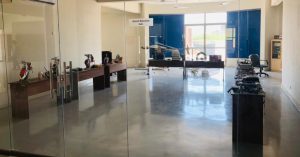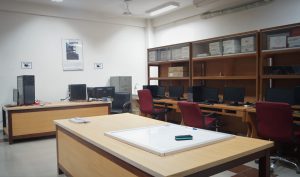Lab Facilities
1-RISE
Purpose of the lab
The Robotics and Intelligent Systems Engineering (RISE) Laboratory is a part of the Department of Robotics and Artificial Intelligence at the School of Mechanical and Manufacturing Engineering (SMME), National University of Sciences and Technology (NUST), Islamabad, Pakistan. RISE lab carries out research in the area of cognitive Robotics, Machine Intelligence, and Human-Robot Interaction with a special focus on design, control, and motion planning for robotic systems including mobile robots, humanoid robots, multi-legged robots, intelligent bionics, and robotic manipulators, etc
Group Members
- Dr. Yasar Ayaz (HOD R&AI)
- Dr. Muhammad Naveed (On Leave)
- Dr. Umar Ansari
- Ms. Sara Baber Sial
- Fatma Faruq
- Mr. Fahad Islam
- Ms. Saadia Qamar
- Mr. Vaqas Arshad (On Leave)
- Mr. Fahad Iqbal Khawaja (On Leave)
- Mr. Fazal Ahmad Azad
External Members
- Dr. Mannan Saeed
- Umar Asif
- Ahmed Hussain Qureshi
Research Areas
- Cognitive robotics
- Machine intelligence
- Design, control, environment perception
- Motion planning for robotic systems
- Mobile robots
- Humanoid robots
- Multi-legged robots
- Intelligent prosthesis bionics
- Robotic manipulators
Industrial & Research Projects (In Progress)
- Humanoids and Legged Robots
- RoboCup: Standard Platforms League
- First and Only Team which qualified for RoboCup Top / Standard Platforms League
- Covered by 6 TV Channels including: BBC, Samaa TV, Channel 92 News HD, Neo TV, Pakistan Television (PTV), Sach TV
- Footstep Planning Among Obstacles for Humanoid Robots
- Cited by Top Universities of more than 12 countries
- NUSTBOT-3 Humanoid Robot
- Third Humanoid Robot in NUSTBOT Robots Series
- Mobile Robotics
- Intelligent Wheelchair Project
- Collaboration: Sakura Wheelchairs, JAPAN & Carnegie Mellon University, USA
- Motion Planning for Mobile Robots
- Environment Perception in Human Environments
- Human Tracking and Following for Service Robots
- Perceptual Aliasing for Service Robots
- Motion Planning
- Sampling Based Optimal Motion Planning
- Cited by top universities including Carnegie Mellon, KAIST etc
- Autowave Based Motion Planning
- Cybernetics and Bionics
- (Collaboration: Armed Forces Institute of Rehabilitation Medicine (AFIRM) & SHIFA International Hospital)
- Human-EEG based control of robots
- Intelligent Robotic Prosthetic Hand.
- Upper Limb Exoskeleton Device
- Active Prosthetic Foot
- Active Ankle-Foot Robotic Exoskeleton Device.
- Human-Robot Interaction
- Communication through Expressive Emotions
- Interactive Humanoid Robot
Publication
| Research Papers | Journals | Conferences | Book Chapters |
|---|---|---|---|
| 40 | | 29 | 1 |
Students Registered With RISE
| PhD Students | MS Students |
|---|---|
| 3 | 10 |
2-AERIAL ROBOTICS
Purpose of the lab
The NUST Aerial Robotics (NU STAR) is a part of the Department of Robotics and Artificial Intelligence at the School of Mechanical and Manufacturing Engineering (SMME), National University of Sciences and Technology (NUST), Islamabad, Pakistan. Unmanned aerial vehicles (UAVs) have been widely used in many fields, particularly in security surveillance, map building, traffic monitoring, an inspection of road/building construction, law enforcement, disaster management, devising emergency responses, field monitoring for agricultural fields, etc. In comparison to other data providing platforms, their usage leads to several advantages including:
- a) Low-cost monitoring over larger regions;
- b) Flexibility in flying across broad temporal and spatial scales;
- c) Capability to carry different kinds of sensors to acquire abundant information
About the area of interest.
- b) Research area
- Vision-based obstacle avoidance and navigation.
- Trajectory generation and trajectory following control.
- Flight planning in complex wind fields.
- Vision-based landing systems.
- Atmospheric sensing.
- Mapping algorithms.
- Brain-controlled robotics.
- Flight simulators design
- c) Lab In charge: Muhammad Jawad Khan
- c) Facilities available
- AF25b Helicopter
- Velocity-90 Helicopter
- Raptor G-4 Helicopter
- Raptor G-4 Helicopter (Battery Based)
- AR Drone Mambo
- Drone Kits
- Vision System
- Air Drop System
- Small Helicopters
- c) Group Members:
Faculty:
- Dr. Hasan Sajid
- Dr. Kashif Javed
- Dr. Umer Ansari
External Collaborators
- Dr Noman Naseer (Air University)
- Dr. Mansoor Shaukat (Technology Spirits)
- Dr. Umer Hameed Shah (Khalifa University, UAE)
- Dr. Raheel Afzal (Flanders Make, Belgium)
- Dr. Hendrik Santosa (Pittsburg University, USA)
Current PhD students:
- 4 PhD students
Current MS Students
- 7 MS students
Graduated MS Students
- 6 MS students graduated
- Affiliated labs:
- NCAI Intelligent Field Robotics Lab
- e) Research project
- SLAM implementation for strategic organization
- SWARM implementation for strategic organization
- f) Patents
Patents Awarded
Reference: 20083-D
Date of Filing: 23/09/2019
Date of Award: 2/07/2020
Title: Actuator of Exoskeleton Hand (Class-03)
Inventors: Muhammad Hamza Asif Nizami, Abdul Rehman, Hamza Butt, Muhammad Hamza Javed, Yasar Ayaz and Muhammad Jawad Khan.
Reference: 20085-D
Date of Filing: 23/09/2019
Date of Award: 2/07/2020
Title: Sixth Finger Actuator (Class-03)
Inventors: Muhammad Hamza Asif Nizami, Abdul Rehman, Hamza Butt, Muhammad Hamza Javed, Yasar Ayaz and Muhammad Jawad Khan.
Reference: 20087-D
Date of Filing: 23/09/2019
Date of Award: 2/07/2020
Title: Brain Imaging Tool for Medical Diagnosis (Class-03)
Inventors: Muhammad Hamza Asif Nizami, Umer Asgher, Sara Ali, Yasar Ayaz and Muhammad Jawad Khan.
- g) Research project funding
NCAI: Intelligent Field Robotics Lab
- Rs. 71.1 M
IST/Strategic Organization
- Rs. 1 M
- h) Research publication (Journal, conference)
- 75
3-CVML
Purpose of the lab
CVML research group is focused on application of machine learning and deep learning algorithms to solve fundamental problems in visual recognition domain including object recognition, object detection, tracking and segmentation. The main application areas are:
- Crowd Management – crowd counting, anomaly detection and flow estimation
- Traffic Management – vehicular traffic flow, automatic license plate recognition, vehicle classification and recognition
- Fault detection – Fabric defect detection, surface defect detection in steel industry
- Visual Surveillance – people counting and facial counting
- Healthcare – Diagnostics
- Agriculture
OIC/PI:
Facilities available
- High End Workstations with Single Nvidia GPUs
- Dual Nvidia GPU workstations
4-PCB
Purpose of the lab
LPKF PCB prototyping systems work directly from CAD data which provides the necessary versatility needed for working on a multitude of various projects, from PCBs to RF enclosures, contour routing, controller housings, faceplates, signs, inspection templates, test fixtures, and even solder paste stencils.
Mechanical and laser systems selectively remove the copper layers on single- and double-sided circuit boards, thereby creating insulating channels that precisely delineate the required conductive traces and pads. The circuit board plotters also drill all the necessary holes in the boards.
OIC/Pi:
Lab Facilities:
LPKF PCB Machine




